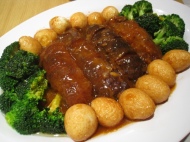Is The Sea Cucumber A Keystone Species?
Ecologists refer to species with wide-ranging effects in an ecosystem as keystone species: in reference, of course, to the keystone in a masonry arch. For years, corals have been recognized as keystone species: they build the reefs on which many species live, they provide food to some species, and feed on others.
Now, scientists at One Tree Island, the University of Sydney’s Research Station on the Great Barrier Reef have found evidence there may be another keystone species on the reef: the lowly sea cucumber.
 Sea cucumbers are rather odd looking, but often colorful, relatives of starfish and sea urchins, resembling giant slugs more than starfish. They often are abundant on coral reefs, feeding on sediments, decaying matter, and algae.
Sea cucumbers are rather odd looking, but often colorful, relatives of starfish and sea urchins, resembling giant slugs more than starfish. They often are abundant on coral reefs, feeding on sediments, decaying matter, and algae.
However, the dietary habits of the sea cucumbers may be critical to the maintenance of coral reefs, including the Great Barrier Reef. As they feed, sea cucumbers ingest sand along with their food. This sand, largely composed of calcium carbonate, is partly digested as it passes through the digestive system of the sea cucumber. Once released into the water, it increases local concentrations of calcium carbonate.
By increasing the concentration of calcium carbonate in ocean water, sea cucumbers support growth of coral- the coral skeleton is largely composed of calcium carbonate. Plus, this calcium carbonate has the benefit of countering the negative effects of ocean acidification, which has resulted from the increased atmospheric concentrations of carbon dioxide attributable to the burning of fossil fuels.
But wait! There is more! Nitrogenous wastes (ammonia) produced by sea cucumbers also serve as fertilizer and serve as an important source of nutrients for coral growth.
So, sea cucumber dung may act as fertilizer and as a buffer against the negative effects of ocean acidification, preserving the health of coral reefs. Beel says, this is important shit.

Braised sea cucumber, bird eggs and broccoli. Doesnt that look tasty! Picture from an Alfa Enterprises web site – a seafood exporter. (Caption and photo from the Abaco Scientist.)
Sea cucumbers, however, are among the largest invertebrates found on tropical reefs and not surprisingly some 30 species are commercially harvested along theGreat Barrier Reefand throughout the tropics. They are prepared in such exotic dishes as, braised sea cucumber. Yum, says Beel.
The Abaco Scientist warns that sea cucumbers are subject to overfishing. Beel recommends that short article and gives it highest honors: 
Beel used Google Insights for Search to examine searches for sea cucumber. Here, Beel presents the results.
Sea cucumbers get no love. What little interest there is, has been going down over time. Perhaps these new findings will reverse this? Beel wonders. Beel asks, what do you think?



I have noticed you don’t monetize your website, don’t waste your
traffic, you can earn extra cash every month because you’ve got high quality content.
If you want to know how to make extra bucks, search for:
Mertiso’s tips best adsense alternative
I have checked your blog and i’ve found some duplicate content, that’s why you don’t rank high in google’s search results, but there
is a tool that can help you to create 100% unique articles, search for; Boorfe’s tips unlimited content